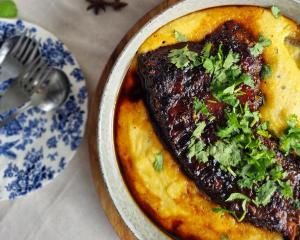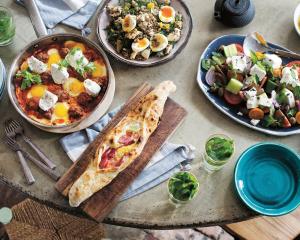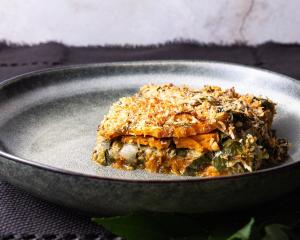
"Exploring the ingredients, cooking, stories and customs of my whanau, many of which have passed down through the generations, and have shaped the way in which we now prepare and share kai.
"Each dish and ingredient carries a story that firmly cements its place in our pataka kai - our kai storehouse."
Lowe describes the book as serving up an abundance of good, hearty kai, classic Aotearoa dishes and modern takes on traditional meals and treats, dishes that evoke food memories and flavours, as well as everyday dishes that can help to make celebrating and gathering memorable and enjoyable.
"This is all about catering for a crowd."
She shares her memories of childhood family feasts where her nana’s desserts were the showstopper dishes elevated above the main dish table, which would be laden with at least three types of meat, usually cooked in the hangi, and steaming bowls of vegetables, rewena bread and kaimoana as well as the history behind such occasions.

Lowe, who is from Feilding, also tells the story of her grandad Don, who died unexpectedly as the book was being written, and of discovering his recipe file in a magazine holder with some books and papers.
"Among the cookbooks were all of his newspaper and magazine cutouts from over the years, along with his handwritten recipes for specialties such as mussel fritters, toroi [fermented shellfish and watercress], pig-head brawn, spring rolls and his famous pineapple-glazed ham. I was overcome with emotion."
Her grandparents fostered a love of good, hearty kai in all of her whanau.
"Our lives seemed to revolve around food: growing it, catching/gathering it, preserving it, cooking it - and of course, sharing it."
The new book is structured to a flow that aligned more with te ao Maori. "More with my heart."
So the recipes are divided into sections based on where they come from - the maunga, from mountain and forest; the waiti, waita, from the waters; whenua, from the land; kai hakari, feast; paraoa, bread; kai reka, sweet things; purini wainene, desserts and keke whakanui, celebration cakes.
Here are a few dishes from menus of gatherings of her family and friends - perfect for a pre-Christmas get-together. - See Lowe’s Christmas dessert in next week’s Fresh Christmas tabloid.
 Takakau flat bread
Takakau flat bread

Makes 8
Ingredients
2½ cups high- grade flour
2 tsp baking powder
½ tsp salt
¾ cup milk
¼ cup olive oil or melted butter
Neutral oil to cook
Butter or garlic herb butter to brush over the breads
Garlic herb butter (optional)
100g butter
2 cloves garlic, crushed
Small bunch fresh herbs, e.g. parsley, basil, coriander, chopped finely
Method
Combine the flour, baking powder and salt in a large mixing bowl.
Add the milk and olive oil or melted butter and mix until it has come together.
Turn out on to a floured benchtop and knead for a few minutes until smooth, adding extra flour if the dough is too sticky.
Put the dough back into the bowl, cover, and rest for 30 minutes.
If you want to brush each flat bread with garlic butter, place the butter in a small saucepan, and when melted stir through the crushed garlic and chopped herbs. Cook for 30 seconds, turn off the heat and set aside.
When ready to cook the takakau, dust the benchtop with flour, and cut the dough into 8 pieces. Roll each piece into a ball and then roll out with a rolling pin to the size of a side plate (about 15cm diameter).
Heat a frying pan or skillet over a medium high heat and add enough oil to lightly cover the bottom of the pan.
Place one flatbread in the pan at a time, and cook for around 1 minute, until the underside has lovely golden patches and the bread has puffed up on top. Flip the bread over and cook the other side for 45 seconds to 1 minute, until golden.
Remove from the pan and brush with butter, or the garlic herb butter if using (melt it again in the saucepan if it has solidified). Keep the cooked breads stacked under a tea towel to keep them nice and soft.
Best served warm, with slow-cooked meat
 Ika mata - raw fish salad
Ika mata - raw fish salad

Serves 4 as a side
Ingredients
500g boneless, skinless white fish, e.g. tarakihi, trevally, snapper, kahawai, blue cod
¼ cup freshly squeezed lemon juice
¼ cup freshly squeezed lime juice (or use all lemon juice)
½ red onion
1 medium capsicum, any colour
1 tomato, or ½ punnet cherry tomatoes
¼ cucumber
2 spring onions
½ cup coconut cream
1 tsp salt, to taste
Small handful coriander, roughly chopped
Method
Dice the fish into 1-2cm cubes, and place in a non-metal bowl. Mix in the lemon and lime juice thoroughly, cover, and leave to chill and marinate in the fridge for 1 hour, or until the fish turns an opaque white colour.
Finely chop the red onion, capsicum, tomato, cucumber and spring onions.
Once the fish has marinated, drain any excess juice away, mix in the chopped vegetables and coconut cream, and season with salt to taste.
Keep chilled until serving.
Mix through the coriander just before serving.
 Umu pulled pork with orange and garlic
Umu pulled pork with orange and garlic

Serves6+
Spicy barbecue rub (best for pork, beef, chicken)
¼ cup brown sugar
1 Tbsp garlic powder
1 Tbsp onion powder
1 Tbsp chopped horopito (dried or fresh), or sage
1 Tbsp dried thyme or oregano
1 Tbsp smoked paprika
1 tsp ground black pepper
1 Tbsp salt
1 tsp chilli powder (optional)
2kg pork shoulder
2 red onions, chopped into chunks
4 cloves garlic, finely chopped
2 apples, cored and quartered, or a bunch of crab apples
½ cup barbecue sauce
Juice of 4 oranges
Salt to season
Quick pickled red onions
2 red onions, thinly sliced
½ cup white vinegar
¼ cup caster sugar
½ tsp salt
Method
Rub the spicy barbecue rub all over the pork. Cover and refrigerate for at least 1 hour, or overnight.
Preheat the oven to 160°C (If using a slow cooker, cook for 5-6 hours on high, or 8-10 hours on low).
Put the pork in a casserole, roasting or Dutch oven dish with a lid, ensuring the dish is big enough so the lid fits properly once all of the ingredients are in.
Add the onions, garlic and apples around the pork, and sprinkle some garlic over the pork as well.
Mix the barbecue sauce and orange juice together, and pour over and around the whole dish.
Cover and cook in the oven, turning the pork occasionally to prevent it sticking to the bottom of the dish, for 4-5 hours, or until the pork falls apart when pulled with a fork.
To make the quick pickled red onions, put all of the ingredients into a medium bowl and massage the onions until soft by squeezing them in your hands. Cover and leave to marinate for at least 30 minutes before serving. Quick pickled red onions can be kept in the fridge, covered, for up to one week.
Remove the pork from the dish and leave it to rest for 10 minutes. Do not discard what is remaining in the dish! After the pork has rested, pull the pork by shredding it with two forks.
Spoon out and discard the excess oil from the top of the sauce remaining in the dish.
Roughly mash the apples and onions and add more water if necessary to create a sauce with a pourable consistency. Season with more salt to taste.
Return the pork to the dish and stir it through the sauce.
Serve with takakau flat bread , quick pickled red onions, coleslaw, and potato salad.
Seasons - By Alison Lambert - Available for purchase now!

The Otago Daily Times and Alison have collaborated to bring you her first cookbook – Seasons.
This book is the ultimate year-round cookbook. Seasons is filled with versatile recipes designed to inspire creativity in the kitchen, offering plenty of ideas for delicious accompaniments and standout dishes that highlight the best of what each season has to offer.
$49.99 each. Purchase here.
$44.99 for ODT subscribers. Get your discount code here.













